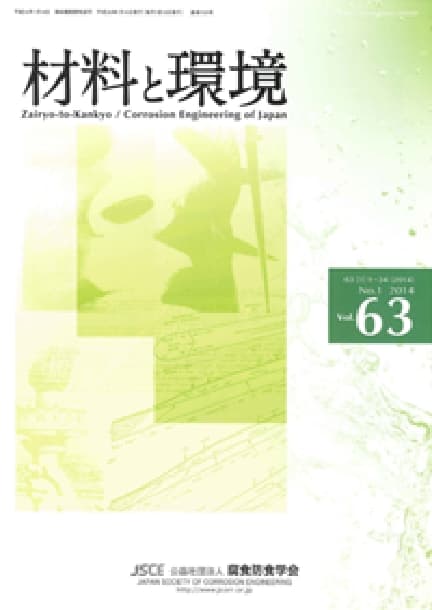- TOP
- Zairyo-to-Kankyo
- Vol. 58 (2009), No. 3
Zairyo-to-Kankyo Vol. 58 (2009), No. 3
Backnumber
-
Vol. 74 (2025)
-
Vol. 73 (2024)
-
Vol. 72 (2023)
-
Vol. 71 (2022)
-
Vol. 70 (2021)
-
Vol. 69 (2020)
-
Vol. 68 (2019)
-
Vol. 67 (2018)
-
Vol. 66 (2017)
-
Vol. 65 (2016)
-
Vol. 64 (2015)
-
Vol. 63 (2014)
-
Vol. 62 (2013)
-
Vol. 61 (2012)
-
Vol. 60 (2011)
-
Vol. 59 (2010)
-
Vol. 58 (2009)
-
Vol. 57 (2008)
-
Vol. 56 (2007)
-
Vol. 55 (2006)
-
Vol. 54 (2005)
-
Vol. 53 (2004)
-
Vol. 52 (2003)
-
Vol. 51 (2002)
-
Vol. 50 (2001)
-
Vol. 49 (2000)
-
Vol. 48 (1999)
-
Vol. 47 (1998)
-
Vol. 46 (1997)
-
Vol. 45 (1996)
-
Vol. 44 (1995)
-
Vol. 43 (1994)
-
Vol. 42 (1993)
-
Vol. 41 (1992)
-
Vol. 40 (1991)
Keyword Ranking
18 Dec. (Last 30 Days)
Zairyo-to-Kankyo Vol. 58 (2009), No. 3
Life Cycle Management of Port Structures – IV
Kazuaki Zen
pp. 82-85
DOI:
10.3323/jcorr.58.82Abstract
Based on the PIANC PTC-II WG31 report1), the LCM of port structures has been introduced in Japan2)-6). Especially, the two repair options with equal lives at the Kamsar Port are economically compared using the Present Worth (PW) method. In present worth analysis, the PW is calculated at the Minimum Attractive Rate of Return (MARR), which is an inflation-free interest rate. When inflation occurs, the effect of inflation on the PW method must be examined.
Since a present worth comparison involves calculating the equivalent present value of all future cash flows for each option, the PW of the options must be compared over the same number of years and end at the same time. The PW comparison of options with equal lives is straightforward. When options being compared have different lives, the Annual Worth (AW) method of comparing options is often preferred to the PW method, because AW comparison is performed for only one life cycle.
In this report, the effect of inflation on the PW method is considered using the data of the Kamsar Port in the WG31 report, and the application of the PW and AW methods to unequal-life options is shown.
Effects of Bubble Behavior on Erosion Corrosion of Copper Tubes in Hot-Water Supply System
Shinobu Suzuki, Yutaka Yamada, Kozo Kawano
pp. 99-104
DOI:
10.3323/jcorr.58.99Abstract
The survey results of recent 120 leakage accidents showed that most of erosion corrosion failures of copper tubes in hot-water forced circulation system have been experienced at the downstream of joints of the return tubes. This tendency was the same as that of the research in 1996. The erosion corrosion of copper tube was observed when the concentration of dissolved oxygen in the hot-supply water was supersaturated and higher than that in supplied tap water. Therefore, it was presumed that erosion corrosion of copper tube was caused by the bubbles formed by pressure change in hot-water forced circulation system. The results of Computational fluid dynamics (CFD) simulations and the observation of the flow pattern in the model plumbing equipment showed that the locus of the micro-bubbles affect of the erosion corrosion of copper tube. According to the Young-Laplace equation, more small bubbles have high pressure in inside of the bubble, and maintain as the bubble without coalesce or collapse of bubbles. Consequently, it could be considered that erosion corrosion of copper tube occurred and propagated when the protective films formed on the tubes surfaces were continuously broken by micro-bubbles.
Corrosion Behavior of AZ31 Magnesium Alloy in Dilute Sodium Chloride Solutions
Lei Wang, Tadashi Shinohara, Bo-Ping Zhang
pp. 105-110
DOI:
10.3323/jcorr.58.105Abstract
Corrosion behavior of AZ31 magnesium alloy in dilute NaCl solutions was studied by electrochemical techniques. Its surface film was chemically characterized by X-ray diffraction (XRD). A corrosion map in terms of electrode potential and chloride concentration [Cl–] was obtained by using electrochemical measurements. With the map, passivation and corrosion zones were determined. The passivation zone was found to become narrow with the increasing of [Cl–] . The values of Eocp, open-circuit potential, in nondeaerated NaCl solutions were in the passivation zone when [Cl–] <0.2 M and in the corrosion zone when [Cl–] ≥0.2 M. The reduction reactions of dissolved oxygen and hydrogen evolution worked as cathodic reactions in nondeaerated solutions. By XRD analyses, Mg(OH)2, magnesium hydroxyl carbonate, and MgO were the dominant products in the corrosion zone, whereas magnesium hydroxyl carbonate and MgO were the main components in the passivated film.
Article Access Ranking
18 Dec. (Last 30 Days)
-
Delayed Fracture Mechanism of 1700 MPa-Class Quenched and Tempered Bolt under Atmospheric Corrosion Environment
Tetsu-to-Hagané Advance Publication
-
Perspectives on the Promising Pathways to Zero Carbon Emissions in the Steel Industry toward 2050
ISIJ International Vol.65(2025), No.2
-
Effect of B on Surface Oxidation Behavior and Phosphatability of Si-Mn-added Cold-Rolled Steel Sheets
ISIJ International Advance Publication
-
Factors Influencing the Bonding Phase Structure of Iron Ore Sinters
ISIJ International Vol.43(2003), No.9
-
Effect of microstructural heterogeneity on fatigue limit of as-quenched low-carbon low-alloy martensitic steel
ISIJ International Advance Publication
-
Prussian blue as a fully reversible hydrogenochromic material for visualizing hydrogen distribution in Fe sheet
ISIJ International Advance Publication
-
Metallurgical Aspects on Interstitial Free Sheet Steel From Industrial Viewpoints
ISIJ International Vol.34(1994), No.1
-
Microstructures and Reduction Properties of High CaO Concentration Sintered Ore
ISIJ International Advance Publication
-
Influence of Antimony on the Oxidation Characteristics of 65Mn Steel
ISIJ International Advance Publication
-
From plasticity to fracture in pearlitic microstructures: Atomistic study of cementite thickness and deformation localization
ISIJ International Advance Publication
You can use this feature after you logged into the site.
Please click the button below.










